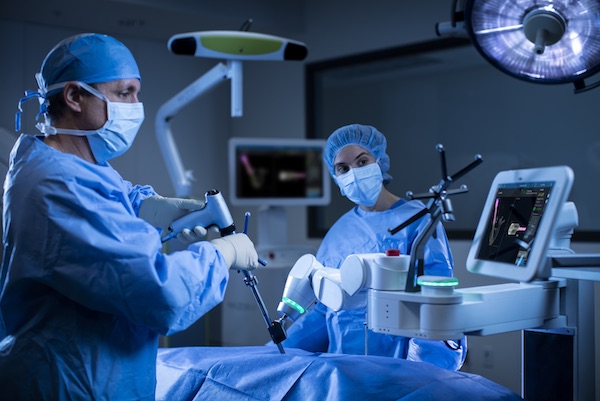Minimally Invasive Robotic Spinal Surgery
Henderson Hospital surgeons use minimally invasive techniques when doing spinal surgery, whenever possible. If you are looking into spine surgery, ask your doctor if a minimally invasive procedure may be right for your particular situation. It is not always the best option for everyone, but it is in many instances.
What to Expect
In minimally invasive surgery, surgeons make small incisions and use small cameras designed for viewing internal portions of the body. This inside view of the body is projected onto monitors in the operating room to aid the surgeon during the procedure.
Minimally invasive techniques often offer several advantages over open surgery (in which one large incision is used), including: smaller incisions and thus smaller scars, minimal muscle-related injury, a shorter hospital stay (two to three days versus five to six), reduced postoperative pain, a shorter recovery period and the ability to return to work and daily activities sooner.
Mazor X Stealth™ Edition Robotic Guidance Platform
Henderson Hospital uses the Mazor X Stealth™ Edition Robotic Guidance Platform, which combines pre-operative planning tools and analytics with intra-operative guidance, giving surgeons advanced spinal surgery options. As spinal surgery has evolved, more focus has been placed on minimally invasive techniques, and this is where the Mazor X StealthTM Edition Platform can deliver its greatest technological benefits.
Minimally-invasive procedures, with their smaller incisions, can pose a challenge to surgeons due to the limited view of the patient’s anatomy. The Mazor X StealthTM Edition Robotic Guidance Platform helps to overcome this challenge with a 3D comprehensive surgical plan and analytics that gives the surgeon comprehensive information and visualization before the surgery starts. Consequently, the Platform supports surgeons’ commitment to operate with precision.
Conditions and Medical Procedures
Surgeons may use the the Mazor X Stealth™ Edition Robotic Guidance Platform to treat multiple conditions that require precise positioning of screws or other implants, particularly in lumbar and thoracic spinal fusions. Some conditions that can be treated include:
- Degenerative disc disease
- Scoliosis
- Spinal fractures
- Spinal implants
- Spinal stenosis
- Spine deformity
- Spine fusion
- Tumors
- Vertebrae fractures
- Walking or movement deformities

Procedures Offered
Here are some of the minimally invasive procedures offered at Henderson Hospital.
Surgery for Cervical Radiculopathy
Cervical (neck) radiculopathy is a compressed or pinched nerve in the neck area. For people with cervical radiculopathy without arthritis of the joints in the neck, a small incision can be made in the back of the neck so that nerves can be decompressed to relieve pain. For people with pre-existing arthritis of the neck, the best option may be a minimally invasive procedure called anterior discectomy — in which an incision is made in the front of the neck.
Once the decompression of the nerve is performed, either fusion (in which two vertebrae are joined) or artificial disc replacement may be performed. This decision is made preoperatively with you and your doctor and is based on the extent of the arthritis. Many patients go home the same day or one day following either procedure.
Surgery for Lumbar Radiculopathy
Lumbar radiculopathy, which is sometimes called sciatica, causes a stabbing pain that shoots from the back or buttocks into the leg. It can also cause numbness or weakness in the leg and foot. The most frequent cause of this condition is a herniated (ruptured) disc in the back, also known as lumbar disc disease. When a disc is herniated, it can create pressure against one or more of the spinal nerves, leading to severe pain, numbness or weakness in the lower back, legs and feet.
With minimally invasive disc surgery, a one-half-inch incision is made in the back so the procedure can be performed through a small hollow tube. A tiny camera is placed into the tube, allowing a clear view of the nerve and its relationship to the herniated disc. This enables the surgeon to remove the herniated disc. Not all herniated disc patients are eligible for minimally invasive spine surgery. The ideal candidate has a well-maintained disc height, preferably with 30 percent or less disc collapse, and no evidence of severe spinal stenosis (build-up of bone in the spinal cavity). Benefits of this approach include reduced time in the hospital and a faster recovery.
Spinal Stenosis Surgery
Lumbar spinal stenosis (LSS) occurs as a result of aging, osteoarthritis and/or everyday wear and tear on the spine. Symptoms can include persistent, progressive lower back pain (with or without radiation), numbness or weakness in the buttocks and legs and symptoms that improve with resting, lying down or bending forward. Stenosis of the spine can also occur in the cervical (upper spine and neck) or thoracic (middle spine) region of the body.
Micro-endoscopic laminotomy (MEL) is a recent treatment option for patients who are candidates for spinal stenosis surgery. MEL accomplishes the same goal of open surgery, but is minimally invasive. With fluoroscopic (X-ray) guidance, a thin needle is placed under the skin on one side of the midline spine. A small (up to one-inch) incision is made around this needle. A set of tapered metal dilators are passed over the guiding needle, and the tissue and muscles are then gently spread off of the underlying bone. Next, a hollow metal cylinder is passed down to the area of the stenosis and secured. A rigid surgical micro-endoscopic camera placed through this working channel provides the surgeon with a close-up, magnified view. With this close-up operative view, the surgeon can micro-surgically remove the bone compressing the nerve roots. Benefits of this approach may include reduced time in the hospital and a faster recovery than open surgery.
Spinal Fusion for Degenerative Spine Disease
People with degenerative spinal disease may require spinal fusion surgery to stabilize the vertebrae and alleviate severe, chronic back pain. Spinal fusion involves correcting an unstable part of the spine by joining two or more vertebrae. Traditional open-surgery spinal fusion has been associated with a low complication rate and pain relief for 90 percent of patients; however, many patients report back pain and fatigue as a result of muscle loss that can occur following surgery.
Laparoscopic spinal fusion is a minimally invasive alternative offered at Henderson Hospital. The lower spinal vertebrae are repaired through an incision directly over the spine (posterior lumbar approach). The upper spinal vertebrae are repaired through an incision in the back or side of the neck (cervical spine). The middle spinal vertebrae are repaired through an incision made in the chest and abdomen (anterior thoracic spine). The abnormal or injured vertebrae are repaired and stabilized with bone grafts, metal rods or both. Benefits of this approach may include reduced time in the hospital and a faster recovery.
Find a Doctor
To obtain a referral to a doctor who practices at Henderson Hospital, contact our free physician referral service at 702-388-4888.
Individual results may vary. There are risks associated with any surgical procedure. Talk with your doctor about these risks to find out if minimally invasive or robotic surgery are right for you.
